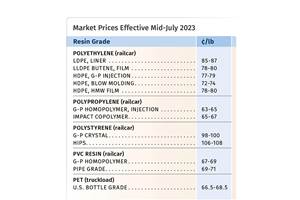Construction Outlook: Residential Recovery Starting
Wood on Plastics
The worst is over but the rebound will be slow.
It has been five long years since the bubble burst in the residential real-estate market, but it looks like the residential construction sector has at last turned the corner. Our forecast calls for a 15% increase in the number of new houses started in the U.S. in 2012. This follows a 3% rise in 2011.
For most markets, a forecast of 15% growth next year would sound wildly optimistic, but as the accompanying chart indicates, even an annual gain of this magnitude does not get the residential construction sector back to anywhere near its pre-bubble range. Residential construction this year will finally start to be a boost to economic growth rather than a drag, but it will take another couple of years before this market can be deemed fully healed.
Housing starts are a crucial leading indicator of future spending patterns for American households, and the fact that this data has remained depressed at very low levels over the past three years is a major reason the recovery in the overall economy has been rather feeble. But as 2012 got under way, the economic recovery was gaining momentum. Thus far, this has spurred apartment demand because at present many households lack either confidence or access to credit, so they will rent rather than buy.
However, pent-up demand is growing and the depressed building levels during the past few years means that inventories of all kinds of new houses are lean. Conditions for single-family construction will emerge more rapidly as job growth and confidence levels grow stronger. For the next couple of years, housing affordability will remain very high and mortgage credit availability will improve slowly but steadily.
So the prospects for processors that supply construction products are looking up, but there are still a few hurdles that must be overcome. In terms of the macro-economy, there are problems in Europe that could spill over and push the U.S. economy back into a recession. This is not the most likely outcome, but households and businesses alike are still a bit on edge after the Great Recession and amid Washington’s partisan acrimony.
The other big hurdle that is currently affecting the housing market is that house prices are still falling, and more than 14 million homeowners are currently underwater on their mortgages. There are some new programs in the pipeline that will help a substantial number of these homeowners refinance their mortgages, but the total number of foreclosures will not start to decline until the third or fourth quarter of 2012. Falling prices and rising foreclosures are stifling the flow of credit, and this will probably only be cured by the passage of more time. This problem will not be completely solved in 2012, but we should see some light at the end of this tunnel by the second half of this year.
Home sales as well as construction of new houses and renovations of existing structures will all start to gain traction by the second half of this year. The prices of fuel and materials (resins, copper, lumber, steel, etc.) are also expected to rise, and this will cause ongoing headaches for consumers, builders, and suppliers alike. It will undoubtedly take a long time for us to get back to the good ol’ days, if we ever do. But this year will be noticeably better than last year, and that is a start.
WHAT THIS MEANS TO YOU
•The worst is over. It might be a good time to review your equipment inventory to see what upgrades might be needed.
•Energy is and will remain a key issue. Focus design and development efforts on products that are energy efficient.
•Resin prices will continue to increase. Processors that figure out a way to make more judicious use of their materials will have a competitive advantage.
Related Content
PS Prices Plunge, Others Appear to Be Bottoming Out
PS prices to see significant drop, with some potential for a modest downward path for others.
Read MorePlastic Compounding Market to Outpace Metal & Alloy Market Growth
Study shows the plastic compounding process is being used to boost electrical properties and UV resistance while custom compounding is increasingly being used to achieve high-performance in plastic-based goods.
Read MorePackaging Waste Will Become Composite Decking
New partnership will incorporate process waste into wood-alternative decking.
Read MoreChemical Recycling Process for Crosslinked PE
Borealis announces capability to produce recycled PE for use in wire & cable, infrastructure industries.
Read MoreRead Next
Lead the Conversation, Change the Conversation
Coverage of single-use plastics can be both misleading and demoralizing. Here are 10 tips for changing the perception of the plastics industry at your company and in your community.
Read MoreUnderstanding Melting in Single-Screw Extruders
You can better visualize the melting process by “flipping” the observation point so that the barrel appears to be turning clockwise around a stationary screw.
Read MorePeople 4.0 – How to Get Buy-In from Your Staff for Industry 4.0 Systems
Implementing a production monitoring system as the foundation of a ‘smart factory’ is about integrating people with new technology as much as it is about integrating machines and computers. Here are tips from a company that has gone through the process.
Read More












.png;maxWidth=300;quality=90)









